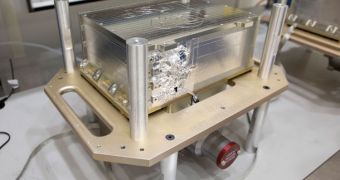Scientists at the Johns Hopkins University (JHU) Applied Physics Laboratory (APL) in Laurel, Maryland, say that the twin NASA Radiation Belt Storm Probes (RBSP) mission has already begun transmiting science data back to Earth.
The two spacecraft launched aboard an Atlas V delivery system on August 30, from Space Launch Complex 41 (SLC-41), at the Cape Canaveral Air Force Station (CCAFS), in Florida.
By September 1, the probes had already begun transmitting data from some of their instruments. The information were relayed through the RBSP Mission Operations Center (MOC), at the APL.
The Relativistic Electron Proton Telescope (REPT-A) instruments, part of the Energetic Particle, Composition, and Thermal Plasma Suite (ECT) on both spacecraft, were turned on 12 hours apart from each other.
Therefore, just three days after launch, experts had access to data relayed back to Earth by the REPT instruments on both spacecraft, from the two Van Allen radiation belts around our planet. The principal investigator of the instruments is University of New Hampshire expert, Harlan Spence.
“We have highly understandable, full science data right out of the box. The REPT units are performing identically in space as they did on the ground, exceeding our highest expectations and delivering outstanding scientific measurements of the radiation belts,” he says.
“We are on the exciting threshold of discovery,” the expert adds, saying that all ECT suites are controlled from the US Department of Energy's (DOE) Los Alamos National Laboratory (LANL).
At the same time the aforementioned instruments were activated, an impressive solar proton emission – the highest recorded over the past couple of months – occurred on the surface of the Sun.
As these protons slammed into the Van Allen radiation belts, the ECT team was able to study the interactions occurring between the two. This is fortuitous, since the instrument suites were originally supposed to be turned on some 30 days after launch.
They were started earlier so that they can collect data at the same time as the NASA Solar Anomalous and Magnetospheric Particle Explorer (SAMPEX) mission. The window of opportunity for the two spacecraft to collect data at the same time is very narrow.
“I went on a campaign to get REPT turned on much earlier to assure that as much overlap of data as possible could occur,” explains Baniel Baker, who is the REPT science lead at the University of Colorado in Boulder Laboratory for Atmospheric and Space Physics (LASP).
“Everybody involved with RBSP, at NASA and APL and the other institutions saw the wisdom of this, and we got the turn-on time moved up,” he concludes.

 14 DAY TRIAL //
14 DAY TRIAL //